Catering Statistics
From large corporate gatherings to small, intimate weddings, caterers play an important role in making any event enjoyable with delectable food and drinks.
We surveyed our catering policyholders to get the inside scoop on which events they’re servicing, what’s on their menu, what technology they’re using to manage their business, and more.
- Corporate parties are the most popular type of event that catering businesses service, according to 68.9% of policyholders surveyed.
- GoDaddy and Wix are top picks for website builders amongst our survey respondents, with 21.2% and 20.4% of respondents using these platforms, respectively.
- 50% of catering business owners surveyed say barbecue/grilled food is the most requested menu item.
- Word-of-mouth referrals are the most common marketing tactic for our respondents, with 89.7% of respondents listing it as their primary method for attracting new clientele.
Types of Catering Businesses
Corporate parties are the most popular type of event for catering businesses, with 68.9% of survey respondents selecting this category.

When it comes to event size, 47.8% of respondents said their average guest count is 51–100 guests.
While our respondents tend to work events of less than 500 guests, 1.5% of them reported average headcounts of over 2,000.
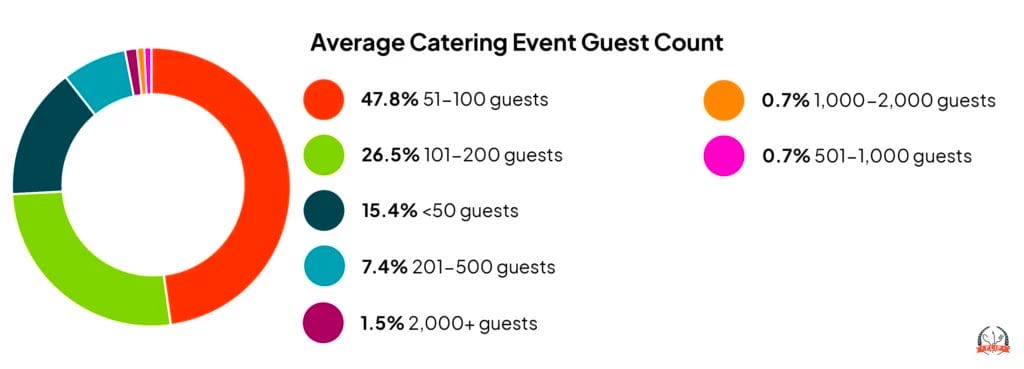
Average Catering Business Salary
38.7% of catering business owners who responded to our survey reported making up to $50,000 in annual gross income in 2023.
A combined 3.7% of respondents made above $300,000 in gross annual income last year. 7.3% reported making no income in 2023 for undisclosed reasons.
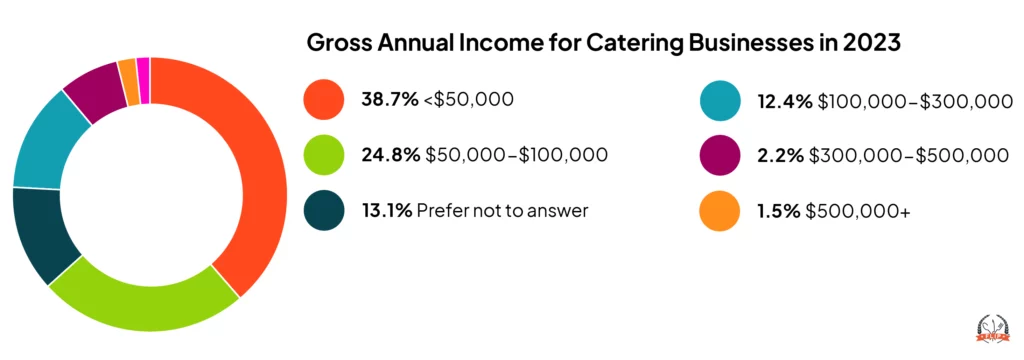
Most Popular Software for Catering Businesses
According to FLIP catering insurance policyholders, QuickBooks is the best accounting software for catering businesses. A whopping 47.8% of our respondents reported using QuickBooks to manage their business finances.
- 4.4% use Wave
- 2.2% use Xero
- 2.2% use Square
However, 29.4% of respondents say they do not use any accounting software for their business. 4.9% specify that they place their finance management in the hands of professional accountants instead.

As for booking software preferences, catering businesses are pretty split. 48% of our respondents said they don’t use any type of booking software to get gigs. Of those that do, 12% use HoneyBook.
- 8% use Square
- 6% use Flex Catering

Some catering businesses allow clients to book services directly through their websites. For business owners who built their own websites, 21.2% used GoDaddy, followed closely by Wix (20.4%).
- 10.6% use Shopify
- 10.6% use Squarespace
- 10.6% use WordPress
- 9.7% use Square Online
While most of our survey respondents have websites for their catering businesses, 6.3% do not. Of those who do not have a website, 2.7% reported using Facebook as their primary business hub instead.
The most popular website builders for catering businesses are GoDaddy and Wix, with 21.2% and 20.4% of survey respondents using them to create their sites, respectively.
Legal Requirements for Catering Businesses
One of the most crucial parts of starting a catering business is acquiring all necessary licenses and permits. Even though the exact requirements vary depending on where you live, there are some permits and licenses that are almost universally required.
A business license and a food handler’s permit are the most popular legal requirements for catering businesses — 81.8% and 81% of survey respondents stated they have these documents, respectively.

Top Menu Items for Catering Businesses
As of 2024, the menu item our caterers say their clients can’t get enough of is barbecue. 50% of our survey respondents say their clients request grilled foods to be served at their events.

As for beverage options, water (61.8%), soft drinks (45.4%), and tea (42.7%) top the list.
Notably, our respondents reported that their clients request mocktails (8.2%) more often than cocktails (5.5%). This echoes a larger trend towards non-alcoholic beverages in recent years.
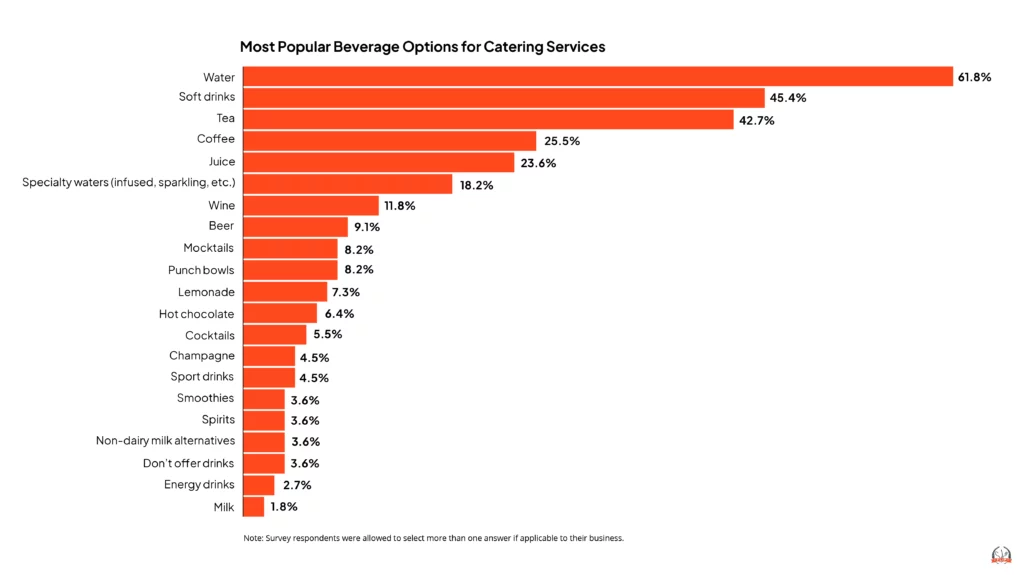
If you include alcoholic beverages in your catering services, make sure you have liquor liability insurance to shield you from the financial impact of alcohol-related claims.
Catering Customer Insights
Trends in Demand
Despite the industry experiencing a major disruption in 2020 with the COVID-19 pandemic, responses to our survey suggest demand for catering services could be on the rise.
42.3% of survey respondents noticed an increase in demand over the past year, though 19.7% reported no noticeable change. While 29.2% saw a decrease, the results overall are cautiously optimistic.
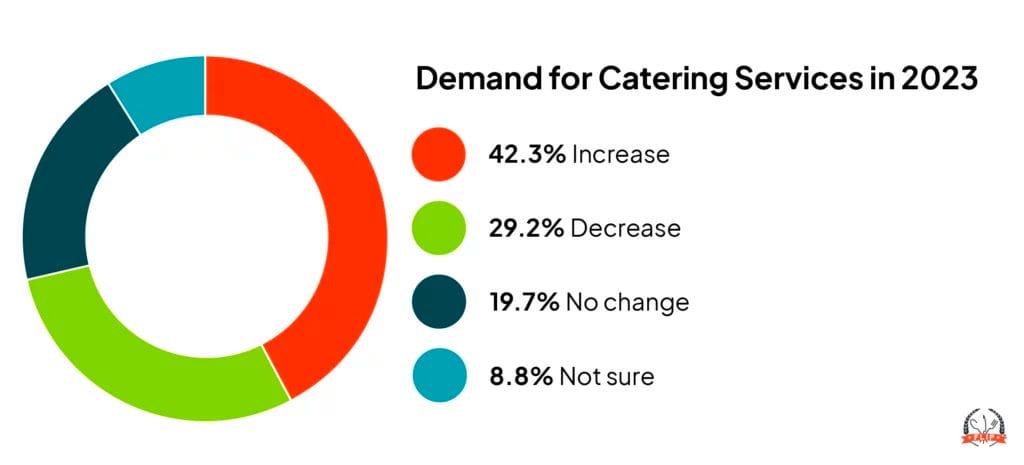
Successful Marketing Tactics
Word-of-mouth marketing referrals are the primary means for attracting new clients for 89.7% of our catering insurance policyholders.

It’s not surprising that social media is the second most popular marketing channel for our catering policyholders when 94% say their business is active across various social platforms.
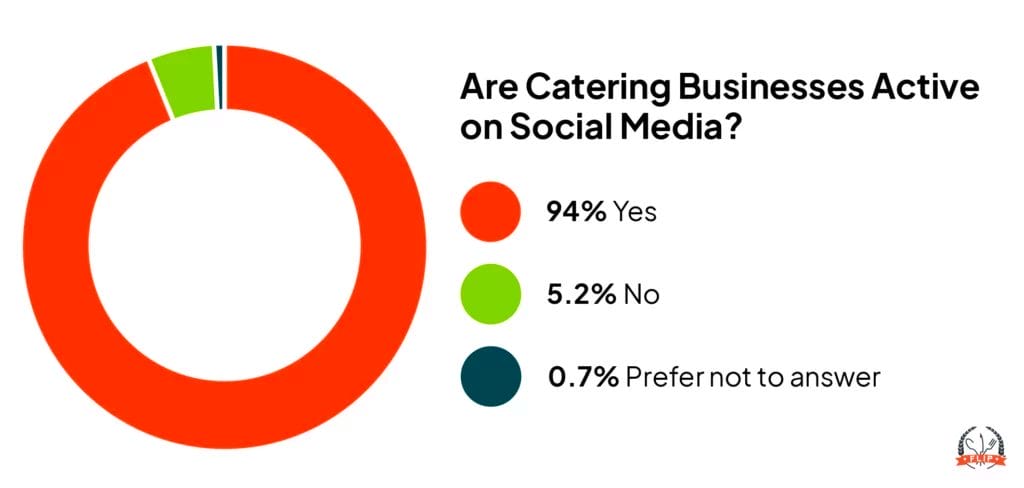
Of those active on social media, 89.9% are on Facebook, making it the best social media app for catering businesses. Instagram comes in at a close second place (85.3%).
Though it’s one of the newer platforms on this list, TikTok is the third most popular social media channel for our catering insurance policyholders at 32.6%. With short-form videos becoming increasingly popular in recent years, we wouldn’t be surprised to see this number grow in 2025.
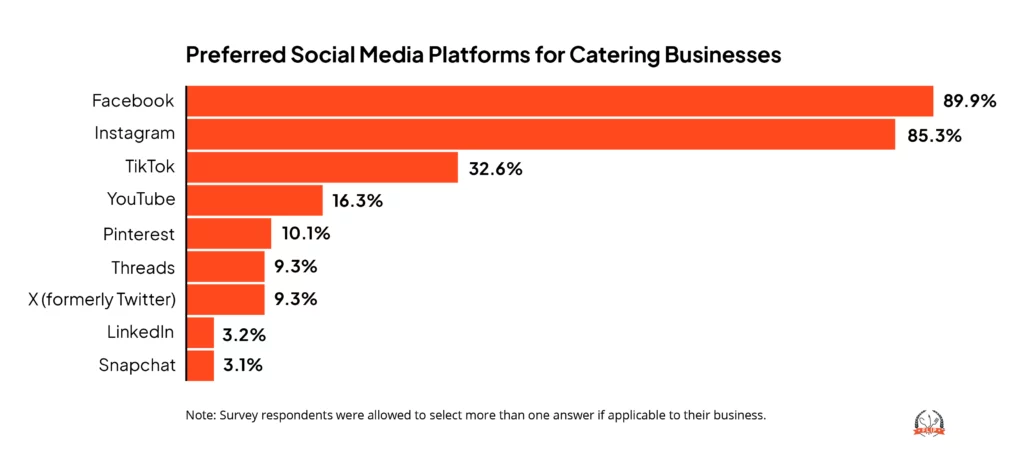
Learn more about how you can use Instagram to reach new clients and retain existing ones!
Insurance Considerations for Caterers
As with all food and beverage businesses, caterers are exposed to a variety of risks that can result in costly claims for your business. The average cost of a catering claim for our policyholders was $4,300 in 2023.
The most common type of claim catering business owners filed last year was damage to rented premises claims, such as spilling oil on the floor of a venue and being held responsible to pay for repairs.
Beyond safeguarding your finances, getting insured is also a critical part of landing gigs for your catering business. 86.2% of our policyholders have been asked to present proof of insurance to an event coordinator or client in order to be hired.
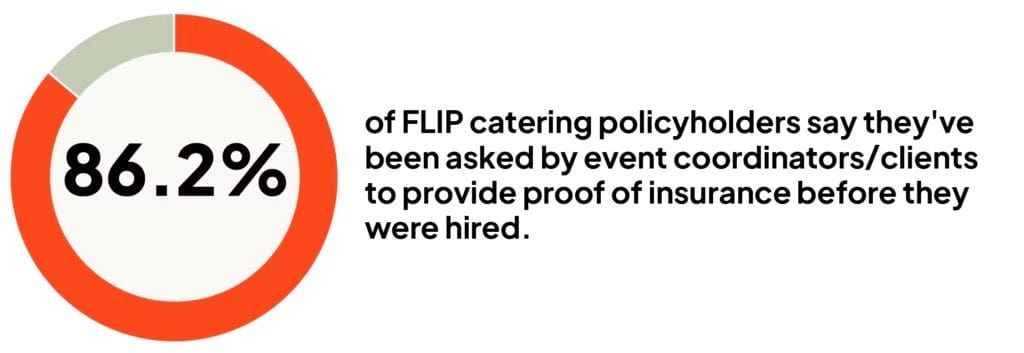
Keep your finances secure and open your business up to more job opportunities with affordable catering insurance from FLIP, starting at just $25.92 per month!
FAQs About Catering Businesses
How Many Catering Businesses Operate in the United States?
There were 97,921 catering businesses operating across the country in 2023, a 6.7% increase from the previous year.
What Are the Average Profit Margins for Catering Businesses?
The average profit margin for the catering sector was between 7 and 8% in 2023.
What Are the Most Significant Challenges Faced by Catering Businesses?
- Seasonality: Catering businesses often experience a spike during the holidays and wedding season followed by dips in demand. Managing expenses (staff, ingredients, etc.) through these ebbs and flows can be difficult.
- Meeting client expectations: Clients with strict budgets might still have extensive customization requests and lofty expectations, so it can be a challenge for caterers to find a middle ground everyone is happy with.
- Variable cost of ingredients: Whether it’s a global supply chain issue or inflation, the amount caterers pay for ingredients can fluctuate. Sourcing from local suppliers can help mitigate these impacts, as they are not as vulnerable to global events.
- Logistics: From transporting ingredients or meals to the venue in a timely manner to coordinating with event planners, venue managers, and clients, caterers often face logistical challenges.
- Adhering to health and safety codes: Caterers must ensure food quality and safety with proper handling and storage techniques to avoid making guests ill and damaging their professional reputation.
What Are the Key Factors Driving Customer Satisfaction in Catering?
- Food quality, flavor, and presentation
- Outstanding customer service (responsive, friendly, willing to customize/make substitutions, etc.)
- Reliability and punctuality
- Hygiene and cleanliness
- Careful planning and attention to detail (location of serving stations at the venue, sufficient quantities of food prepared for the event, etc.)


